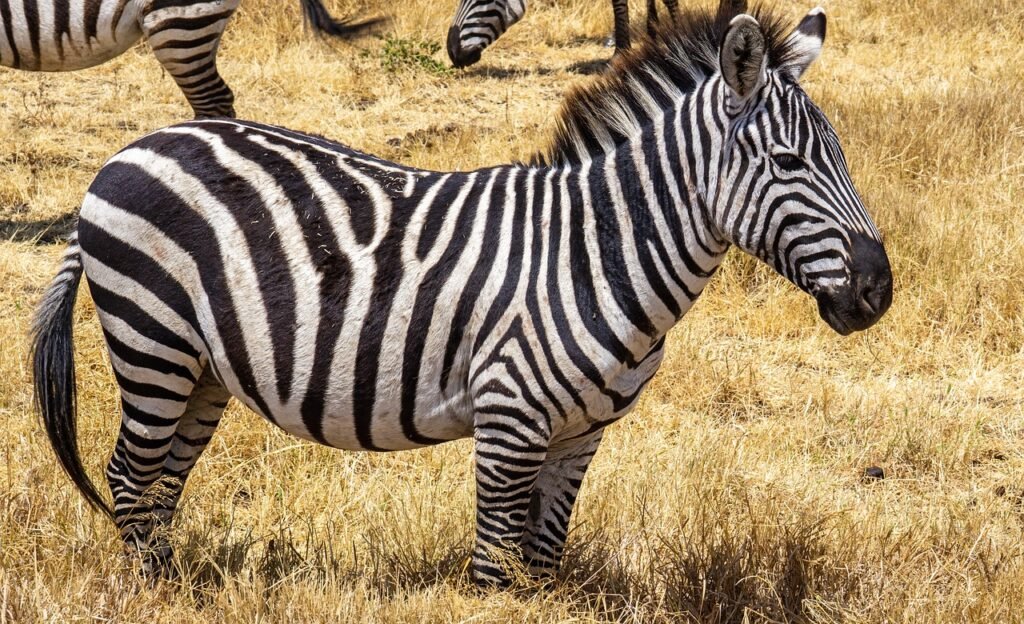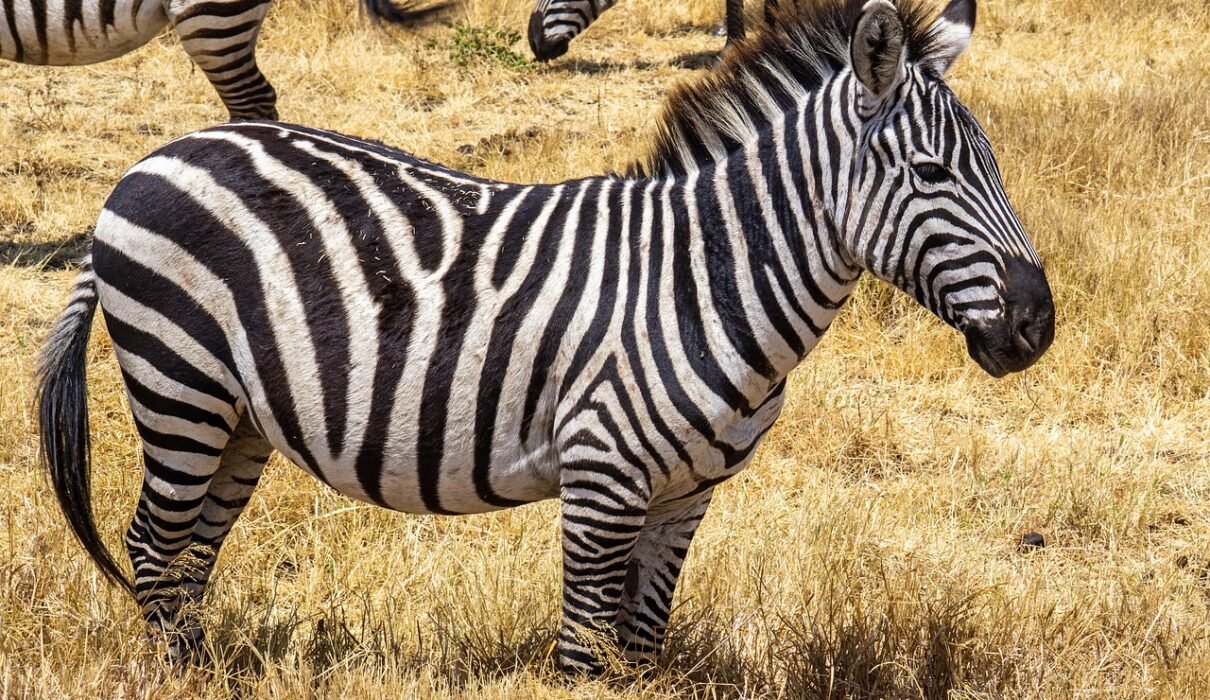Fascinating Facts About Plains Zebras : The plains zebra is one of Africa’s most iconic animals, known for its distinctive black-and-white stripes and its vital role in the ecosystem. These zebras, which are found across the savannahs of Eastern and Southern Africa, play a crucial part in the food chain and maintain grassland health. In this article, we’ll explore some fascinating facts about plains zebras, shedding light on their unique traits, behavior, and importance in African wildlife.
Learn more about plains zebra safaris in Tanzania.

Fascinating Facts About Plains Zebras : Unique Stripes: Nature’s Camouflage?
The most striking feature of the plains zebra is, of course, its black and white stripes. But did you know that no two zebras have the same stripe pattern? Each zebra’s stripes are as unique as human fingerprints.
Theories Behind Zebra Stripes:
- Camouflage: The stripes may confuse predators by disrupting their vision, especially when zebras are moving in a group.
- Insect Deterrence: Some studies suggest that stripes help deter biting flies and other insects.
- Temperature Regulation: Another theory is that the alternating black and white stripes help zebras regulate their body temperature by reflecting different amounts of light.
Discover more about the purpose of zebra stripes.
Fascinating Facts About Plains Zebras – Social Structure: Family Matters
Plains zebras are highly social animals that live in groups called harems. A typical harem consists of one stallion, several mares, and their foals. The stallion protects the group, while the mares share responsibilities for watching over the young.
Harems vs. Herds:
- Harems: Small family groups that stay together for long periods.
- Herds: Multiple harems often come together to form large herds, especially during migration or in areas with abundant resources.
- Why It Matters: The strong social bonds in harems help protect zebras from predators, as they can warn each other of approaching danger.
Learn more about zebra social behavior.
Fascinating Facts About Plains Zebras – Plains Zebras Are Constantly on the Move
Plains zebras are nomadic grazers, always on the move in search of fresh grass. They play a key role in maintaining the health of Africa’s grasslands by grazing on older, tougher grasses, allowing newer, more nutritious grass to grow.
Role in Ecosystem:
- Grazers: Zebras eat a wide variety of grasses, which helps prevent overgrowth and keeps the grasslands balanced.
- Migration: In some regions, zebras migrate alongside wildebeests and gazelles, traveling long distances to find water and fresh grazing land.
Explore the role of zebras in Africa’s ecosystem.
Fascinating Facts About Plains Zebras – Plains Zebras Have Excellent Communication Skills
Zebras use a combination of vocalizations, body language, and even their ears to communicate with each other. For example, if a zebra’s ears are pulled back, it’s likely showing aggression, while forward-pointing ears signal curiosity or attention.
Vocal Communication:
- Barks: Zebras often bark to warn their group of approaching predators.
- Whinnies: These high-pitched sounds are used to greet or find other members of the herd.
Learn more about how zebras communicate.
Striped Foals: Born with Brown Stripes
When zebra foals are born, their stripes are not black and white, but brown and white. As the foal grows, its brown stripes gradually darken to black. Newborn zebras can walk within minutes of birth and can keep up with the herd after just a few days.
Foal Facts:
- Mother-Baby Bond: Zebra mothers keep their foals close during the first few days so the baby can imprint on her unique stripe pattern.
- Growth: Foals are weaned at around 6 to 7 months old, but they may stay with their mother for up to a year.
Discover more about zebra foals.
Fascinating Facts About Plains Zebras : Plains Zebras Are Fast Runners
Zebras are built for speed and can run at speeds of up to 65 km/h (40 mph). This makes them excellent at evading predators like lions and hyenas. When chased, zebras often zigzag to confuse their pursuers and give them a better chance of escape.
Running Strategy:
- Zigzagging: A tactic used to confuse predators by changing direction rapidly.
- Endurance: Zebras can maintain a fast pace for long distances, which helps them outrun predators over time.
Learn more about zebra speed and survival tactics.
Fascinating Facts About Plains Zebras : Predators and Survival Strategies
The plains zebra’s main predators are lions, hyenas, and crocodiles. While zebras are fast runners, they also rely on their strong social bonds to protect themselves. When threatened, the herd will bunch together, and the stallion will often position himself between the danger and the rest of the harem.
Defensive Tactics:
- Group Defense: By staying together, the zebras create confusion for predators, making it harder to target a single individual.
- Kicking: Zebras can deliver powerful kicks, which can be strong enough to injure a predator.
Explore zebra defense mechanisms against predators.
Plains Zebras Face Conservation Challenges
While plains zebras are not currently endangered, they do face threats from habitat loss, competition with livestock, and illegal hunting. Conservation efforts focus on protecting their habitats and managing human-wildlife conflict to ensure that zebra populations remain stable.
Conservation Status:
- Near Threatened: Although still abundant, some populations are in decline due to habitat encroachment and poaching.
- Protected Areas: National parks and reserves, such as the Serengeti and Maasai Mara, are crucial for the survival of zebra populations.
Learn about zebra conservation efforts.
Fascinating Facts About Plains Zebras : Plains Zebras and the Great Migration
Each year, millions of plains zebras take part in the Great Migration, moving across Tanzania’s Serengeti and Kenya’s Maasai Mara in search of fresh grass and water. This incredible journey is one of the largest wildlife migrations on Earth, and zebras play a key role in the ecosystem as they graze ahead of wildebeests.
Migration Facts:
- Distance: Zebras travel over 1,800 miles during the migration, following seasonal rains.
- Teamwork: Zebras often migrate with wildebeests, as their differing grazing habits complement each other.
Learn more about the Great Migration.

Fascinating Facts About Plains Zebras : Conclusion
The plains zebra is more than just a beautiful animal—it plays a vital role in maintaining Africa’s ecosystems and supporting the food chain. From their unique stripes to their strong social bonds and survival strategies, zebras are a fascinating species that deserves attention and protection. Whether you’re exploring the Serengeti or simply learning about wildlife, understanding the significance of zebras helps highlight the importance of conservation efforts.
For more information on safari tours and zebra conservation, visit Kilimanjaro Climb Specialist or Eddy Tours & Safaris.

